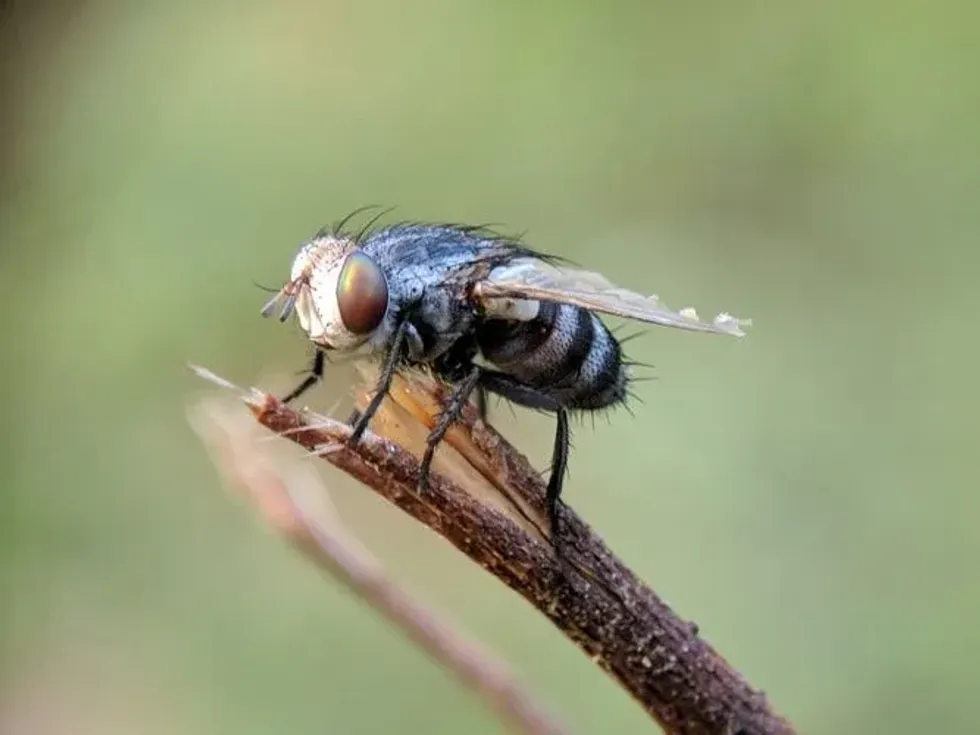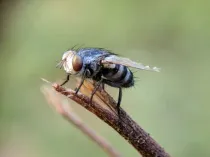Flies belong to the order Diptera, which gets its name from the Greek words di-'two' and pteron 'wing'. Although the name flies has been given to a variety of insects, it belongs specifically to the Diptera class.
There are several types of flies like a house fly, fruit fly, horse-fly bee fly, drain fly, tsetse fly, lantern fly, may fly, scorpion fly, sand fly, yellow fly, and more.
We try to keep flies away with the help of fly repellent, fly paper, and other such deterrents as they spread numerous illnesses like E.coli and Salmonella. They often vomit or excrete after landing on our edibles, breaking down the food particles into smaller pieces, and proceed to eat this poop or vomit.
Thus, spreading various germs and illnesses. Many people make fly traps with the help of jars, vinegar, and water.
Interestingly, fly bites are more common than you think. While some bites like the female black fly bite feeding on blood and are not particularly painful, the deer fly bite is painful and causes welts or bumps, giving you rabbit fever. A fly's predators are birds and other bigger insects.
Read on to know more fascinating facts about flies. If you enjoy this article then you should check out our articles on damselfly and jumping spider.
Fly Interesting Facts
What type of animal are flies?
The animal fly is a type of insect.
What class of animal do flies belong to?
Flies belong to the class of Insecta.
How many flies are there in the world?
According to rough estimates by scientists, there are almost 17 million flies for every person on Earth.
Where do flies live?
Flies are terrestrial beings and can be found in many places. For example, house flies can be found in houses, in ceilings, walls, floor, plants, garbage cans, and in many more places, while fruit flies prefer places closer to food like kitchens, restaurants, and more places as such.
What is a fly's habitat?
Flies can live in almost any form of environment or organic matter. In lakes, birdbaths, marshes, wetlands, swamps, puddles, rivers, and even in brackish water, the larvae of aquatic species of flies can be found.
Some larvae can be seen burrowing into bottom sediment while others live in the branches, roots, and leaves of plants. Non-aquatic flies can be found in soil, algae, herbs, trash, barks, dead bodies, houses, and kitchens. Flies prefer a warm and moist climate as it helps them breed.
Who do flies live with?
Flies generally live together in small packs and are found inhabiting places with humans because this leads them to food sources like fruits, vegetables, or garbage.
How long do flies live?
All flies live for an average of 30-60 days. House flies complete their life cycle in about 30 days out of which they spend 25 days as an adult.
Fruit flies stay in the larvae and pupae stage for about a week or two before becoming adults, in which stay they live for about 40-50 days. The larval stage of bigger flies like deer flies and horse flies lasts one to three years.
Most adult flies cannot survive winter but their larvae or pupae can. If a fly does survive winter, it is due to hibernation.
How do they reproduce?
Flies go through complete metamorphosis, whereby they undergo four stages i.e. egg or embryo, larva, pupa, and adult.
The release of tempting chemical odors or pheromones by female flies signals that they are ready to mate. Complex mating exercises exist in some species.
For example, in the case of fruit flies, to successfully seduce the female fly, the male follows a set of steps. Even after the female issuing pheromones, he has to assure her that he is the best suitor. He starts by tapping the female on the stomach with his leg.
This is followed by him strutting about with the vibration of his wings, 'singing' to her. If these steps are not completed in the correct sequence then the male fly is doomed.
Flies usually lay their eggs in huge numbers. They lay eggs in dozens and hundreds, and wet places like vegetables, fruits, carrion, fungi, manure, and inside their host in case of parasitic species.
In her lifetime, a single housefly the Musca domestica can lay 600 eggs and more with almost 10 or more generations within one single breeding season. Eggs hatch about 8-20 hours later in humid weather on the basis of the species. In some cases, live maggots are born which then feed on garbage and carcasses.
What is their conservation status?
While some flies like common house flies or fruit flies are found in abundance and have no conservation issues, there are some species of fly that are threatened or rare. Some like bog hoverfly or Clubbed General Soldier fly are becoming rare due to their habitat loss.
Fly Fun Facts
What do flies look like?
Flies come in a variety of colors like black, brown, or gray. Some of them maybe are brightly colored or pale on the basis of the species. A fly's body is divided into three sections: head, thorax, and abdomen. It usually has a slender body and long legs.
To provide support and protection, the body is encased in an exoskeleton made of chitin, a durable and versatile material. On the body, there are bristles and hairs. Some flies have more hairs and bristles than others.
How cute are they?
A fly is not considered cute because it creates unhygienic and unhealthy environments for others which leads to the spreading of numerous diseases.
How do they communicate?
A fly can communicate with each other by making vibrations through their body parts like wings or legs. They can also communicate by using various sound effects like tremors on the surface they are in, creating air currents and water ripples.
How big is a fly?
Flies are tiny insects with a length of about 0.2-0.3 in (0.6-0.7 cm). It is about 10 times smaller than the Bee Hummingbird, which is the smallest species among the birds.
How fast can flies fly?
A fly can only travel about 13 mi (21 km) from its birthplace. The maximum speed of a common housefly is about 4.3 mph (7 kph) even with its wings beating approximately 20,000 times per minute.
How much does a fly weigh?
A fly is a tiny insect. It weighs around 0.00007-0.0016 oz (2-45 mg).
What are their male and female names of the species?
There are no specific names for the male and female flies.
What would you call a baby fly?
A baby fly is called fly larvae or pupae depending on its life stage. Also, they are called maggots in some species.
What do they eat?
Flies prefer natural content and various nutrition sources as their meal. Some eat meat scraps, others like fruit flies prefer ripe fruits and vegetables while some are attracted to yeast or dairy products.
For example, females of certain species drink blood while some like Hessian flies feed on grass. Some flies like the crane fly do not consume anything after being an adult.
Larvae eat a wide range of plants and animals as food, and some larvae among them are even parasitic, Larvae of quite a few many species are found feasting on rotten garbage and carcasses.
Flies can only digest food in a liquid state or particles less than 0.02 in (0.5 mm), so solids must be dissolved in saliva or stomach acids regurgitated.
Are they dangerous?
Flies are dangerous because they are capable of spreading several diseases. While they do not excrete every time they land, flies can defecate every four to five minutes and do so anywhere.
You can be sure that they can do it on your food or on you. As a result, it is easy for them to spread diseases like E.coli and Salmonella.
Flies can contaminate food too because they tend to cling to a surface or position for a prolonged period of time. The sticky pads on their feet are to blame for this.
Would they make a good pet?
Flies do not make a good pet. One of the most important reasons for this is because you cannot keep them anywhere.
Due to their food choices, they would feed on rotting food or garbage, making your house stink. Also, if you keep flies, they would breed at a very fast rate which would quickly turn into an infestation. A fly is also responsible for spreading numerous diseases, thus hampering the health of your loved ones.
Did you know...
Flies have an extraordinary ability to smell from miles away. According to reports, house flies can smell from about 4 mi (6.4 km) away.
Can flies chew?
Flies cannot chew their food. They lack teeth or any other mouthparts which will allow them to chew. This is why they secrete digestive juices onto solid food which breaks it into small particles, allowing the fly to drink the meal using their proboscis.
How do flies taste?
Flies taste food with their feet. This is due to the presence of taste receptors or chemonsensilla on their lower legs and feet. When a fly lands on a tasty meal, which can range from animal feces to your lunch, it will sometimes walk around to give its next meal a taste before consuming it.
Here at Kidadl, we have carefully created lots of interesting family-friendly animal facts for everyone to discover! Learn more about some other arthropods including wolf spider, or Africanized bees.
You can even occupy yourself at home by drawing one on our fly coloring pages.










